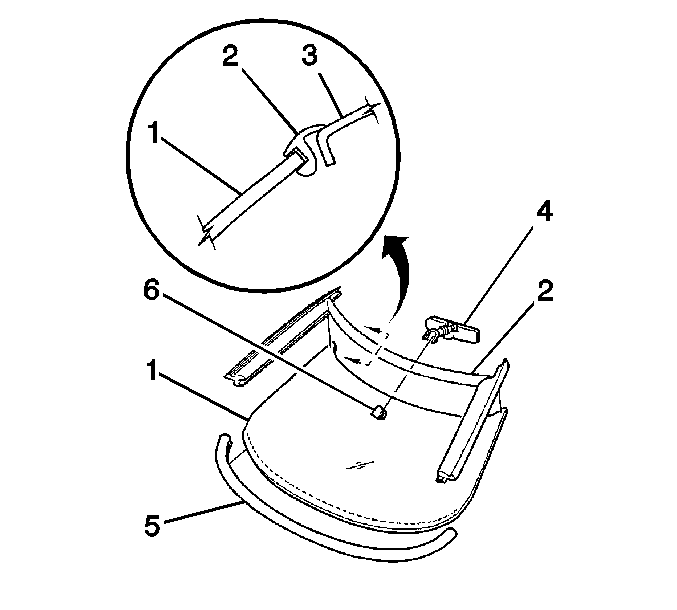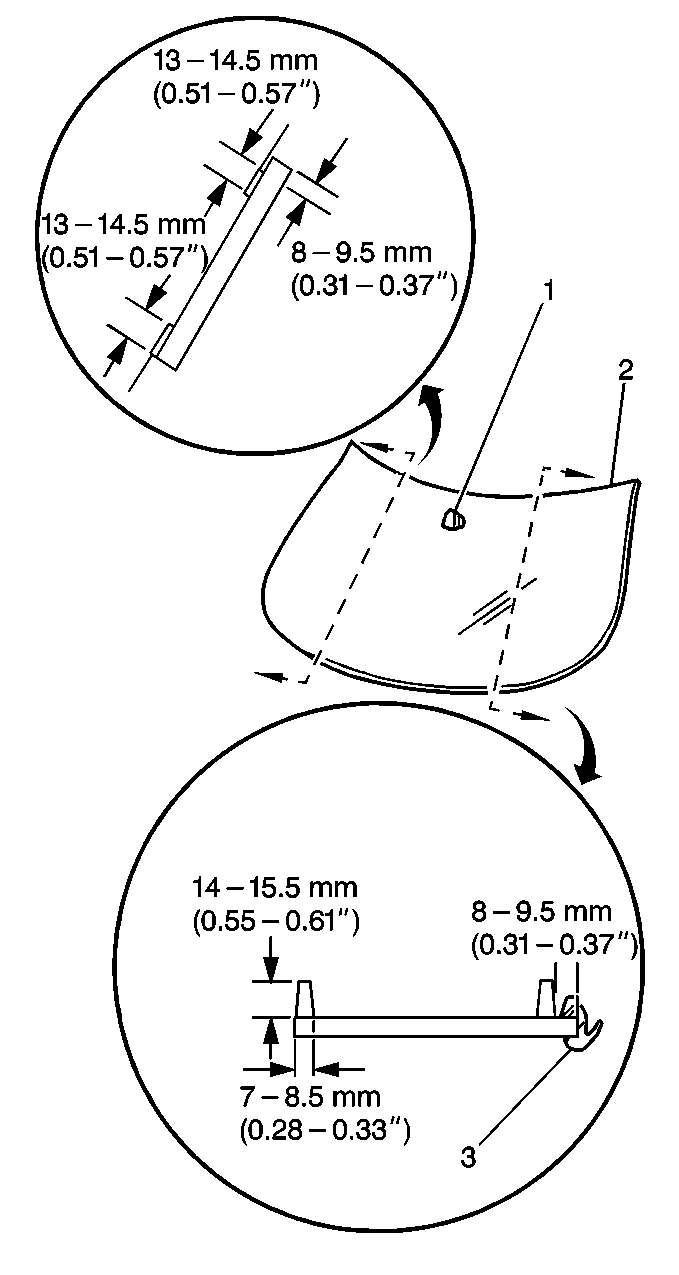- Install the I/P upper trim pad. Refer to
Instrument Panel Upper Trim Pad Replacement
in Interior Trim.

- With the aid of an assistant,
dry fit the windshield (1) in the opening to determine the correct
position. Use the following procedure:
| 2.1. | Position the windshield (1) in the opening. |
| 2.2. | Use masking tape in order to mark the location of the windshield
(1) in the opening. |
| 2.3. | Slit the masking tape at the window edge. |
| 2.4. | Remove the windshield (1) from the opening. |
| 2.5. | Place the windshield (1) inside up on a clean protected surface. |
- Clean the surface around the inside edge of the windshield (1)
where the urethane adhesive will be applied. Use a dampened cloth with either
isopropyl alcohol or GM Window Cleaner P/N 1050427 or the equivalent.
Caution: When replacing stationary windows, use Urethane Adhesive Kit GM P/N 12346392
(Canadian P/N 10952983), or a urethane adhesive system meeting GM Specification
GM3651G, to maintain original installation integrity. Failure to use the urethane
adhesive kit will result in poor retention of the window which may allow unrestrained
occupants to be ejected from the vehicle resulting in personal injury.
Caution: Failure to prep the area prior to the application of primer
may cause insufficient bonding of urethane adhesive. Insufficient bonding
of urethane adhesive may allow unrestrained occupants to be ejected from
the vehicle resulting in personal injury.
- If you are using the extended method of installation, perform
the following:
| • | Shake the pinchweld primer #3 (black) well. |
| • | Apply the primer to any exposed painted surfaces (or scratches
to bare metal) on the pinchweld flange. |
| • | Allow the primer to dry 10 minutes. |
- If you are using the short method, DO NOT prime the existing bead
of urethane adhesive on the body.
- Refinish the pinchweld flange in order to present a Primer Only
surface if the following conditions exist:
| • | Corrosion of the pinchweld flange is present |
| • | Sheet metal repairs or replacements are required |
| • | If paint repairs are required, mask the flange bonding area first |
| • | Appropriate materials for these primer applications are typically
two component, catalyzed products such as BASF DE17, DUPONT2610, PPG DP90
or equivalent applied by following the manufacturers directions
for mix, application and dry times. |
| • | After repairing the opening as indicated, perform the following: |
| • | Shake the pinchweld primer #3 (black) well. |
| • | Apply the pinchweld primer to the primed surface of the flange
in the bonding area. |
| • | Allow to dry 10 minutes. |
- If reusing the original windshield (1) , remove any existing urethane
adhesive from the windshield (1) edge and surface. Use a razor knife or the
equivalent.
- If you are using the original reveal molding (2) or production
type reveal molding, install the molding (2) along the edge of the window.
- Install a new sealing strip weatherstrip (5) on the windshield
(1), as needed.
- If you are using the extended method, use the following procedure:
| • | Apply a dam material approximately 12 to 18 mm (0.47
to 0.71 in) from the outer edge of the window and around the perimeter
of the window to control urethane squeeze out. |
| • | For dam material, use Norton Windshield Dam Replacement. |
| | Important: Do not allow the window preparation #1 (clear) to drip or spill onto
the vision area of the windshield (1). The primer dries instantly and may
stain the viewing area if not applied evenly.
|

- Use a new dauber to apply
the glass preparation #1 (clear) approximately 10 to 16 mm (0.39
to 0.63 in) around the entire perimeter of the inner
surface. Also apply the glass preparation to any exposed edge
of the window (2).
Wipe dry the area using a clean cloth.
- Shake the window primer #2 (black) well. Use a new dauber to apply
the primer over the glass preparation #1 (clear) that was applied in the previous
step.
- Allow the primer to dry for 6 to 10 minutes.
Important: Do not apply the clear primer over the black primer. Do not touch the
primer coated surface.
- If you are using the short method, cut the tip of the applicator
nozzle to provide a bead of urethane adhesive 4.5 mm (0.18 in)
in diameter.
- If you are using the extended method, cut the applicator nozzle
to provide a bead of urethane adhesive 7-8.5 mm (0.28
to 0.33 in) wide by 14-15.5 mm (0.55 to 0.61 in)
high.
- Use a cartridge type caulking gun in order to apply a smooth continuous
bead of urethane adhesive.
Use either of the 2 following procedures:
| • | For the short method, apply urethane adhesive to the existing
bead of urethane adhesive on the body. |
| • | For the extended method, use the edge of the windshield (2) or
the inside edge of the reveal molding (3) as a guide for the nozzle. |
| • | Apply the urethane adhesive to the inner surface of the windshield (2). |
| • | Use rubber suction cups to install the windshield (2). |
| • | Use as assistant to help with the installation. |
- Align the windshield (2) with the previously installed masking
tape.
- Firmly press the windshield (2) into place.
- Tape the windshield (2) to the body in order to minimize movement
and in order to clean up any urethane squeeze out.
Important: Do not direct a hard stream of high pressure water at the fresh adhesive.
- Immediately watertest the window.
- Use a soft spray of warm or hot water in order to accelerate the
cure of the adhesive.
Refer to
Water Hose Test
in Waterleaks for the water test procedures.
- If leaks are found, use a plastic paddle in order to apply extra
urethane adhesive at the leak point.
- Remove the protective tape and coverings.
Caution: At least 24 hours are required for complete curing of repair
material. The repair area should not be physically distrubed until after that
time. Insufficient curing of urethane adhesive may allow unrestrained occupants
to be ejected from the vehicle resulting in personal injury.
- Allow the vehicle to remain at room temperature, 22°C (72°F)
and 30 percent relative humidity for a minimum of 6 hours.
- Partially lower a door window in order to prevent pressure build
up when closing the doors before the urethane adhesive cures.
Do not drive the vehicle until the urethane adhesive is cured.
Do not drive the vehicle for a minimum of 6 hours.
Do not use compressed air in order to dry the urethane adhesive.
- Install the T-tops, if equipped.
- Install the air inlet grille. Refer to
Air Inlet Grille Panel Replacement
in Body Front End.
- Install the wiper arms. Refer to Windshield Wiper/Washer Systems.
- Remove the windshield reveal molding. Refer to
Windshield Reveal Molding Replacement
.
- Install the inside rearview mirror. Refer to
Inside Rearview Mirror Replacement
.



